Exploring the Rhodochrosite Gem: Properties and Significance
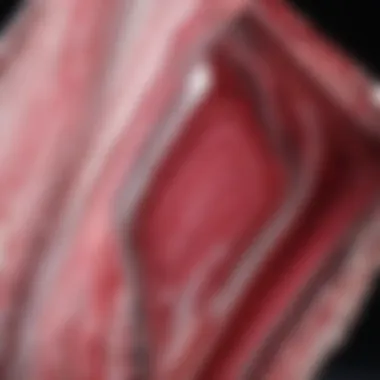
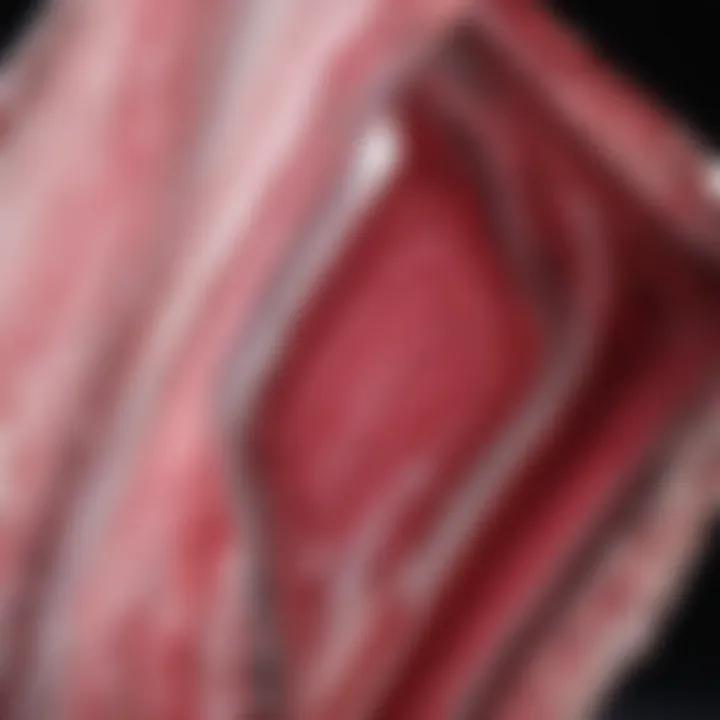
Intro
Rhodochrosite is a gem that captivates not only with its striking pink to red hues but also with its intriguing history and uses. This mineral, primarily made of manganese carbonate, is not commonly found in large quantities, making it a favorite among collectors. As we delve into its properties, origins, and significance, we uncover what makes rhodochrosite a treasured piece in the mineral world.
Featured Collectible of the Month
Overview
Rhodochrosite has gained attention for its stunning coloration and distinct banding. These features often resemble the flow of water, marking its presence in various geological formations. The gem is uniquely identified by its hardness, which ranges around a 3.5 to 4 on the Mohs scale, indicating a moderate resistance to scratching. Because of these characteristics, it is often carved into various shapes, enhancing its aesthetic and collectible value.
Historical Significance
Historically, rhodochrosite has been linked to multiple cultures. Ancient civilizations, including the Incas, regarded it as a sacred stone. They referred to it as the "Inca Rose". The vibrant colors were believed to symbolize love and compassion. In more modern contexts, it became popular in the 19th century, particularly in the field of mineralogy and jewelry making. Today, its significance spans from ornamental use to healing practices, where it is believed to assist in emotional balance and self-love.
Rhodochrosite represents more than just a pretty rock; it embodies a rich narrative of cultural appreciation and significance.
Identification Techniques
Visual Characteristics
When attempting to identify rhodochrosite, consider its distinct visual traits:
- Color: The primary color ranges from pink to red, sometimes with white or light pink banding.
- Luster: It typically has a vitreous to pearly luster.
- Form: Often found in rhombohedral crystals or in masses, it exhibits unique formations, which can enhance its appeal.
- Transparency: Rhodochrosite can be transparent, translucent, or opaque depending on the specific specimen.
Resources for Identification
For deeper understanding and verification of rhodochrosite specimens, consider the following resources:
- Wikipedia on Rhodochrosite
- Britannica Article
- Communities on Reddit for mineral collectors
- Collector groups on Facebook that focus on gems and minerals.
In sum, rhodochrosite stands out as a gemstone with a blend of beauty and history. It is not only appreciated for its visual allure but also for its cultural significance and healing properties. As collectors further explore this mineral, they uncover layers of meaning that deepen their appreciation of this remarkable gem.
Prelude to Rhodochrosite
Rhodochrosite, a captivating mineral, often commands significant interest among collectors and researchers alike. This section seeks to provide a foundational understanding of what rhodochrosite is, its key characteristics, and its historical context. Gaining insights into rhodochrosite is crucial for appreciating its unique properties and significance within the broader spectrum of mineralogy and cultural heritage.
Definition and Characteristics
Rhodochrosite is a manganese carbonate mineral with the chemical formula MnCO₃. It is readily identifiable by its distinctive pink to red coloration, often presenting with banded hues that further enhance its aesthetic appeal. The color results from the presence of manganese ions within its crystalline structure. Generally, the mineral is found in a variety of forms, including massive, botryoidal, and stalactitic structures, which display unique textures and patterns.
In terms of physical properties, rhodochrosite displays a Mohs hardness rating of 3.5 to 4.5. This makes it relatively soft, meaning it can be scratched by harder minerals. It has a vitreous to pearly luster and exhibits perfect cleavage in three directions, which can complicate its use in certain jewelry applications. The mineral is also a notable source of manganese, an essential element used in various industrial processes.
Historical Overview
The historical relevance of rhodochrosite is rooted deeply in various cultures and traditions. The name itself is derived from the Greek words "rhodon," meaning rose, and "chros," meaning color. Since its discovery in the 18th century, its striking beauty caught the eye of collectors and lapidaries.
Rhodochrosite has been mined in several regions across the globe, particularly in Argentina, where it is the national gemstone. The mining of rhodochrosite dates back to the Inca civilization, who valued it for both its beauty and supposed properties as a protective talisman. In more contemporary times, it has played a role in the world of gemstones and jewelry, further solidifying its place within mineralogical studies and the collector's market.
Understanding both the definition and the historical aspects of rhodochrosite presents a clearer picture of its importance. The gem holds value not only as a beautiful specimen but also as a piece of cultural legacy, meriting exploration and appreciation in the context of both geology and history.
Physical Properties of Rhodochrosite
The physical properties of rhodochrosite are fundamental in understanding this unique gemstone. These characteristics influence not just its appearance but also its durability, desirability, and applications in various fields. By gaining knowledge of color variations, hardness, and crystal structure, collectors can make informed decisions regarding their specimens, appreciating the intricate details that define each piece.
Color Variations and Patterns
Rhodochrosite displays a rich range of colors, primarily shades of pink to red, often with beautiful white banding. This unique banding results from the mineral's crystalline structure, which allows for patterns that resemble the lines of a fingerprint. The intensity of the pink can vary significantly due to iron content and the specific environmental conditions during formation. Specimens from some locations exhibit striking hues that can move from light pink to deep red, each variation telling a unique story of geological processes.
Collectors value these variations not only for their beauty but also for the indicators they provide about the mineral's origin. In some regions, like Argentina, deeper colors signify specific geological processes, while other areas produce lighter stones with more subtle patterns. Some notable examples include the Alma King Mine in Colorado, where collectors often seek out specimens for their rich color and unique bands. These attributes enhance the aesthetic appeal and serve as a symbol of nature's artistry.
Hardness and Durability
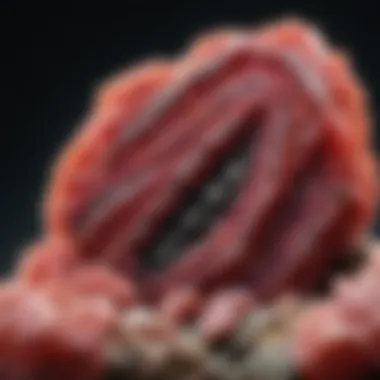
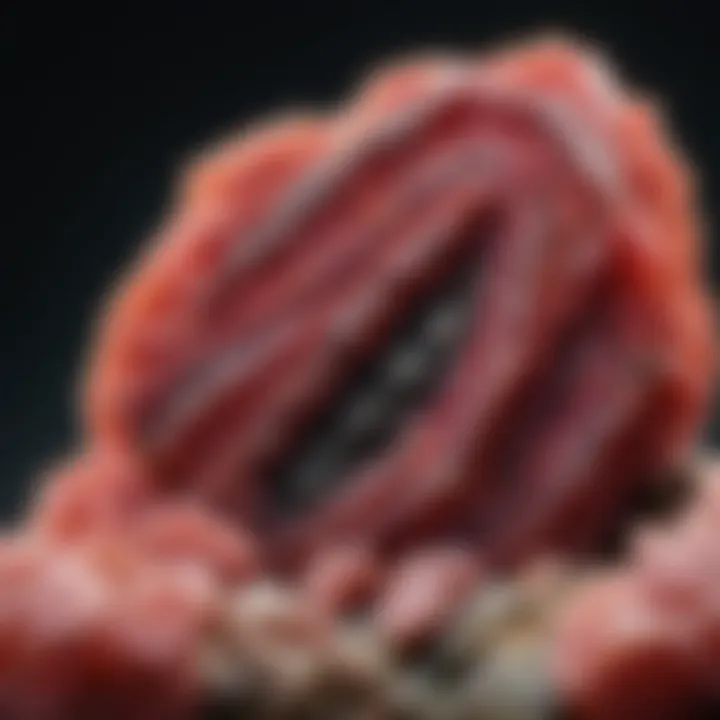
In the Mohs scale of mineral hardness, rhodochrosite ranks between 3.5 and 4. This relatively low hardness means that while it is beautiful, it is also somewhat fragile compared to other gemstones. Care must be taken when handling or displaying rhodochrosite, as it can scratch or chip easily. Due to its softness, rhodochrosite is not recommended for daily wear jewelry, where it might be exposed to rough handling and abrasion.
Understanding the hardness of this gem is essential for collectors. It dictates how the gem should be cared for and the environments best suited for its display. For example, when arranging a display case, other harder stones should be kept separate to avoid damage.
Crystal Structure
The crystal structure of rhodochrosite classifies it as a carbonate mineral. It typically forms in a rhombohedral lattice, which leads to its characteristic rhombohedral crystals. This geometric formation not only affects its physical appearance but also its optical properties. Rhodochrosite can exhibit cleavage in three directions, which contributes to its unique visual effects and enhances the gem's allure. The repeating unit cell in the crystal lattice also dictates how light interacts with the stone, giving rise to its shiny luster.
The orderliness within its crystal structure is vital for gem enthusiasts, as it informs about the quality of the specimen. Well-formed rhombohedra signal a higher-grade specimen, which is more desirable in the market.
"Understanding the physical properties of rhodochrosite equips collectors with the knowledge to better appreciate and care for their gems."
To summarize, the physical properties of rhodochrosite play a critical role in identifying, appreciating, and collecting this unique mineral. From its stunning color variations, relative softness, to its distinctive crystal structure, each aspect tells a part of the rhodochrosite story, enriching the collector's experience.
Geological Formation of Rhodochrosite
The geological formation of rhodochrosite holds significant importance in understanding not just the gem itself, but also the broader frameworks of mineralogy and geology. Knowledge of rhodochrosite's formation provides insights into the Earth's processes, revealing how various factors contribute to the creation of minerals. This gem's properties are closely tied to its geological roots, making this section vital for collectors and enthusiasts alike.
Origin and Geographical Distribution
Rhodochrosite is primarily found in regions with hydrothermal activity. Some of its most notable occurrences include Argentina, where large deposits are located in the province of San Luis, and the United States, particularly in Colorado. Other locations where rhodochrosite can be found include South Africa and Spain. Each geographical area contributes distinct qualities to the crystal, reflecting the local geological conditions.
- Argentina: Known for rock formations rich in manganese, where the ideal conditions for rhodochrosite's growth exist.
- United States: Notably in Colorado, where rare specimens have drawn collectors because of their vibrant colors.
- South Africa and Spain: Smaller deposits, still valued by collectors for their rarity and uniqueness.
The differences in color and texture seen among these specimens can tell a story about the environment in which they formed. For instance, varying levels of impurities during the crystallization process can influence the final appearance of the stone.
Environmental Conditions for Formation
The formation of rhodochrosite relies heavily on particular environmental conditions, mostly involving the presence of manganese-rich water solutions. These solutions percolate through limestone and other rocks, precipitation occurs when the right temperature and pressure conditions are met. This process typically takes place over millions of years. Tempers and pH levels play a crucial role in determining the characteristics of the crystalline structure formed.
The ideal conditions for rhodochrosite formation include:
- Hydrothermal Environments: Hot water solutions are key in transporting the minerals needed for crystallization.
- Alkaline Conditions: These conditions promote the formation of carbonate minerals, where rhodochrosite often forms.
- Low to Moderate Temperature: This facilitates the natural crystallization process.
Understanding these conditions offers valuable insights for collectors. Recognizing where and how rhodochrosite forms can enhance their ability to identify high-quality specimens.
Rhodochrosite in Culture and History
The cultural and historical significance of rhodochrosite is profound. This unique gem has captured the interest of various civilizations throughout history. Its vibrant colors and distinct patterns have not only made it a favored stone for ornamentation but have also imbued it with diverse meanings in different cultures. Understanding these cultural ties offers depth to the appreciation of rhodochrosite, transforming it from just a beautiful mineral into a symbol of heritage and belief.
Symbolism in Various Cultures
Rhodochrosite carries different meanings across cultures. For the Inca civilization, it was often referred to as the "blood of the Inca" because of its deep red hues, which were associated with vitality and passion. It was believed to be a protective stone, safeguarding the wearer against negative energies. The Inca used it in various ornaments, symbolizing status and spirituality.
In modern metaphysical practices, rhodochrosite is celebrated for its ability to promote emotional healing. It is often associated with self-love, compassion, and nurturing. Many believe it aids in overcoming past traumas and enhances the process of personal growth. In this context, its pink tones symbolize love and emotional balance, making it a popular choice among healers and collectors.
Furthermore, certain groups view rhodochrosite as a stone of joy. Its vibrant colors, ranging from deep pink to light rose, are said to resonate with the heart chakra. This belief is prominent in various self-care and wellness traditions, where rhodochrosite is used in meditation and healing practices to attract positive energies.
Historical Uses and Significance
Historically, rhodochrosite was not just a decorative stone; it found utility in various artifacts. In the late 19th century, the gem gained popularity in Europe as a material for jewelry. Important historical figures, such as Queen Elizabeth II, have been known to adorn themselves with rhodochrosite pieces, contributing to its elevated status.
Moreover, during the 20th century, rhodochrosite gained prominence in the field of mineralogy. Geologists and collectors began to appreciate it for both its beauty and the roles it played in mineral composition studies. Its occurrence in certain regions, like Argentina, where it was discovered in the mid-1900s, further sparked interest among enthusiasts and collectors.
Rhodochrosite is much more than a mere gemstone; it holds power in symbolism and a rich tapestry of historical context.
Today, its significance extends into contemporary culture, where it is often linked to metaphysical practices. Various healing communities regard it as an essential stone for emotional clarity and spiritual well-being. Collectors often seek rhodochrosite not only for its beauty but also its historical ties and versatility in various cultural contexts.
Collecting Rhodochrosite
Collecting rhodochrosite is an engaging pursuit for both serious enthusiasts and casual collectors. This unique mineral stands out not just for its beauty, but also for its fascinating history and geological significance. Rhodochrosite exhibits vibrant colors and distinct banding patterns, making each specimen a treasure. Understanding the nuances of collecting can enhance the overall experience and investment value.
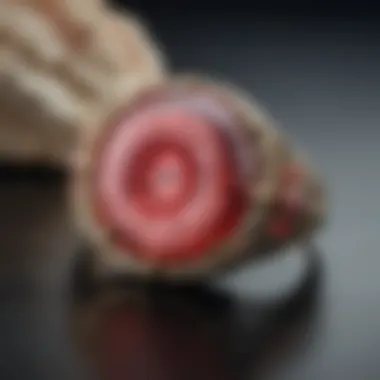
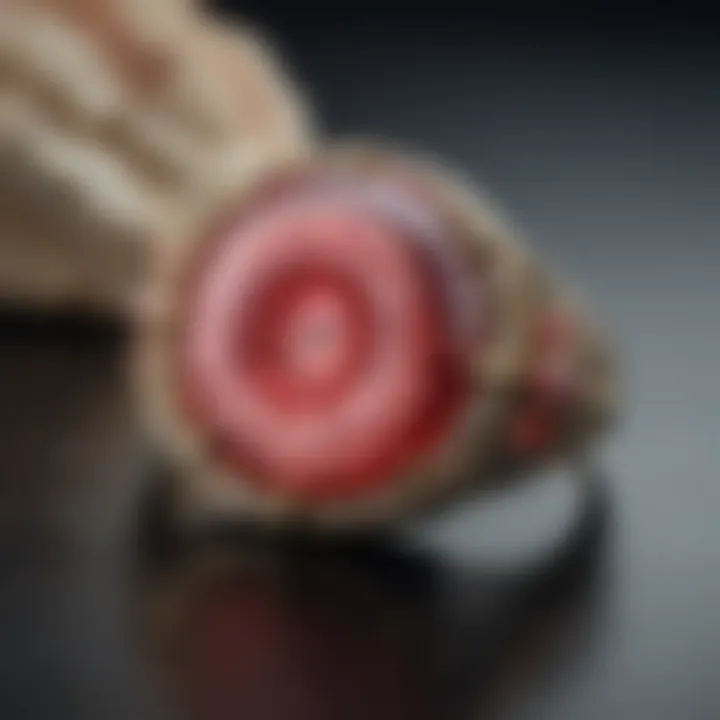
Identifying Quality Specimens
When searching for high-quality rhodochrosite, collectors should focus on several key factors. First, consider the color. The ideal specimens showcase rich, vibrant hues ranging from deep pink to rosy-red. A uniform color distribution with less mottling is often more desirable. Additionally, the presence of well-defined bands can greatly enhance the aesthetic appeal.
Another important aspect is clarity. While many rhodochrosite specimens contain inclusions, those with minimal to no visible imperfections can command higher prices. It is also essential to pay attention to the size and overall shape. Larger pieces with unique formations are rarer and are often more sought after.
Color uniformity, clarity, and unique banding are essential aspects when identifying quality rhodochrosite specimens.
Market Trends and Rarity
The market for rhodochrosite has fluctuated over recent years, influenced by trends in both collecting and jewelry making. The demand for this gem has seen spikes as more people discover its unique properties. Such interest can lead to increased values, especially for rare specimens or those sourced from specific locations.
Certain regions, like Argentina and the United States, are known for producing high-quality rhodochrosite, but these sources are dwindling. The result is a growing rarity of top-tier specimens, which often translates to higher prices. Collectors should stay informed about current market trends to make well-timed purchases or sales, especially as new deposits are discovered or existing ones become exhausted.
Ethical Considerations in Collecting
As with any mineral collecting, ethical considerations play an important role in building a responsible collection. It is crucial for collectors to ensure their rhodochrosite specimens are sourced sustainably. This involves purchasing from reputable dealers who prioritize environmentally friendly practices.
Collecting rhodochrosite should not come at the cost of local communities or ecosystems. By choosing ethically sourced materials, collectors can contribute to sustainable mining practices. Additionally, being informed about the laws regarding mineral collection in different regions is essential to avoid legal repercussions. Collectors can also support conservation efforts by participating in organizations focused on mineral preservation.
The Role of Rhodochrosite in Healing Practices
Rhodochrosite is not just admired for its visual appeal but also for its believed benefits in healing practices. This section highlights the significance of this gem in various healing modalities and its purported metaphysical properties. Understanding these aspects can enrich the perspective of collectors and enthusiasts alike, as it ties the beauty of the mineral to deeper, more personal connections.
Metaphysical Properties
Rhodochrosite is often associated with the energy of love and compassion. It is said to help balance emotions and foster feelings of self-worth and self-love. Collectors often find it appealing not only for its color but also for the emotional support it may provide. The gem is believed to resonate with the heart chakra, promoting healing of past emotional wounds and releasing negative energies.
Some specific properties attributed to rhodochrosite include:
- Emotional Healing: Supports individuals in overcoming traumas and finding emotional stability.
- Enhancement of Self-Esteem: Encourages individuals to embrace their true selves and recognize their worth.
- Inspiration: Can spur creativity and inspiration, aiding in personal expression.
Rhodochrosite’s pink and red hues symbolize love and physical well-being, making it not only a decorative piece but also a potential source of emotional comfort and strength.
Techniques and Uses
Utilizing rhodochrosite in healing practices can take many forms. Below are some common techniques and uses adopted by practitioners:
- Meditation: Holding or placing rhodochrosite on the heart chakra can help in deepening meditative states, leading to better emotional insights.
- Crystal Grids: Integrating rhodochrosite into crystal grids can enhance healing energies, especially when combined with other compatible stones.
- Wearable Jewelry: Wearing rhodochrosite as jewelry can provide continuous support throughout the day. Many people choose to wear rings or pendants.
- Affirmations: Pairing rhodochrosite with positive affirmations may amplify the emotional healing process. Speaking affirmations while holding the stone may reinforce confidence and self-love.
Understanding how to incorporate rhodochrosite into healing practices offers a more holistic appreciation of this mineral. Whether one is a serious collector or just starting, recognizing its healing aspects provides depth to the overall experience.
Caring for Rhodochrosite Crystals
Caring for rhodochrosite crystals is essential for preserving their beauty and integrity. Being a relatively soft mineral, rhodochrosite requires special attention to maintain its quality. Appropriate cleaning practices, coupled with proper storage, ensure that the crystals remain vibrant and free from damage. This section outlines techniques for cleaning, maintenance, and optimal storage solutions for rhodochrosite collectors, enhancing the longevity of their prized specimens.
Cleaning and Maintenance Techniques
While rhodochrosite is admired for its stunning color variations, it is also sensitive to harsh treatments. Proper cleaning can help maintain the appearance of the crystal without compromising its quality. Here are some effective cleaning methods:
- Gentle Hand Cleaning: Use lukewarm water and a mild soap to clean rhodochrosite. Avoid any abrasive materials that may scratch the surface. A soft cloth or sponge can be used for gentle scrubbing.
- Avoid Chemical Cleaners: Stay clear of strong chemicals or cleaning agents as they can degrade the crystal’s surface and alter its color.
- Drying: After rinsing, gently pat the crystal dry with a soft, lint-free cloth. Avoid air drying in direct sunlight, which may cause fading.
Regular maintenance ensures the crystals remain in top condition. It’s advisable to handle rhodochrosite with care to avoid chips and scratches. Minimizing exposure to dirt and oils from hands can also prevent buildup and preserve the gem’s natural luster.
Storage Guidelines
Proper storage is key to protecting the delicate nature of rhodochrosite crystals. Here are some guidelines to consider:
- Use Soft Pouches or Cases: Store rhodochrosite in soft fabric pouches or padded boxes to reduce the risk of scratching or damage from other objects. Avoid storing multiple crystals together in a way that they can bump into each other.
- Temperature and Humidity Control: Keep the crystals in a controlled environment. Extreme temperature fluctuations or high humidity may adversely affect the mineral's structure.
- Display Considerations: When displaying rhodochrosite, use a glass case or cabinet to protect it from dust and accidental contact. Avoid sunlight exposure, which may lead to color fading over time.
Proper care and storage can significantly extend the life of your rhodochrosite collection. Taking the time to follow these techniques can preserve the beauty and value of each piece.


By following these cleaning and storage practices, collectors can ensure their rhodochrosite crystals not only remain visually stunning but also retain their unique properties for years to come.
Rhodochrosite in Jewelry Making
Rhodochrosite holds a distinct place in the world of jewelry, known for its vibrant colors and unique appearance. This gem is more than just a decorative piece; its utilization in jewelry carries symbolic meaning and is appreciated for its aesthetic and energetic properties. The striking pink to red hues, often with white bands, make it a favorite among jewelers and collectors alike.
Popular Designs and Settings
Jewelry designers often embrace rhodochrosite for its luxurious appearance and versatility. Common pieces include:
- Necklaces and Pendants: Rhodochrosite is frequently cut into cabochons for pendants, allowing its natural patterns to shine. These pieces often emphasize the stone's unique coloration.
- Earrings: Rhodochrosite beads in earrings can either maintain a simple design or feature intricate settings to hold the gem securely while showcasing its beauty.
- Bracelets: The stone’s durability supports its use in bracelet designs, making them suitable for daily wear.
Settings vary from minimalist designs, which highlight the gemstone itself, to more elaborate settings, incorporating silver or gold. The contrasting metals enhance rhodochrosite’s softness, creating a balanced appearance.
Market Demand and Pricing
The market demand for rhodochrosite jewelry is influenced by several factors:
- Rarity: Quality rhodochrosite, especially that with vibrant color and unique patterns, is becoming increasingly scarce. This rarity drives up the price, making high-quality pieces more desirable.
- Quality of Craftsmanship: The skill of the jeweler also affects pricing. Well-crafted pieces that carry artistry command higher prices in the market.
- Trends: The popularity of unique and natural gemstones influences buying patterns. Collectors and everyday consumers know rhodochrosite for its distinctive look and are willing to invest in pieces that stand out.
Typically, the price can range significantly depending on the quality and size of the piece. As more collectors seek out uncommon stones, the value of rhodochrosite continues to rise, positioning it as both a collectible and stylish choice.
"Rhodochrosite is not just a gem. It is a representation of natural beauty, distinctiveness, and timelessness stitched into the fabric of fine jewelry."
Scientific Research on Rhodochrosite
Scientific research on rhodochrosite contributes significantly to our understanding of this remarkable mineral. The study of its physical and chemical properties enhances knowledge in the fields of mineralogy and gemology. This section will look at two vital areas: applications in mineralogy and innovations in gemology. Each of these domains reveals unique insights about rhodochrosite, thus enriching the perspective of collectors and enthusiasts alike.
Applications in Mineralogy
In the field of mineralogy, rhodochrosite is important for several reasons. Firstly, its composition can reveal information about geological processes. Chemically classified as a manganese carbonate, the mineral is often found in hydrothermal vein deposits. These deposits form under specific conditions that are crucial for understanding mineral formation in different environments.
Rhodochrosite also serves as an indicator mineral. Geologists can use it to locate other valuable minerals in an area. For collectors, knowing where rhodochrosite is found helps identify potential mining sites. Additionally, the mineral's zoning patterns can provide clues about its growth conditions.
Research has shown that rhodochrosite can exist in various forms, such as massive, stalactitic, and botryoidal, each offering different research opportunities. Study of these formations not only benefits mineralogists but adds depth to geological exploration and education.
Innovations in Gemology
Recent innovations in gemology concerning rhodochrosite are noteworthy. Advances in laser technology, for example, enable gemologists to analyze the mineral's internal characteristics in detail. This analysis helps differentiate natural specimens from synthetic or treated ones, which is critical for maintaining market integrity.
Furthermore, developments in spectroscopy provide valuable data regarding rhodochrosite's color variations. Recognizing these variations is key for valuation and helps ascertain which pieces hold more aesthetic and material worth.
A significant trend in gemology is the focus on ethical sourcing. Research into fair mining practices enhances the reputation of rhodochrosite as a gem. Buyers increasingly favor responsibly sourced stones, making this research vital for both gemologists and collectors.
Overall, the scientific exploration of rhodochrosite is an essential aspect of understanding its significance in mineralogy and gemology. Through rigorous study, we gain valuable insights that inform both academic knowledge and commercial practices.
Culmination
The conclusion of this article emphasizes the multifaceted significance of rhodochrosite, a gem with much more depth than its stunning appearance suggests. Understanding rhodochrosite not only involves an appreciation of its aesthetic qualities but also a recognition of its geological origins, cultural importance, and modern applications. These factors contribute to its value among collectors and mineral enthusiasts.
Recap of Rhodochrosite's Importance
Rhodochrosite is not just an attractive mineral. It is rich in history and significance. Its unique pink to red colors stem from the presence of manganese, leading to a beautiful variation that attracts collectors. The stone has historical ties to various cultures, symbolizing love and emotional healing.
In contemporary contexts, rhodochrosite is valued for its metaphysical properties, often associated with self-love and self-healing. Musicians, artists, and healers have used it to inspire creativity and foster emotional balance. Collectors see it not just as a specimen, but as a testament to Earth's geological processes.
Furthermore, the rarity of quality rhodochrosite crystals adds to its allure in the mineral market. As demand persists, understanding its properties and origins will help collectors make informed choices.
Future Perspectives in Collecting and Use
Looking ahead, the focus on rhodochrosite is likely to grow, particularly in the realms of both collecting and healing practices. Collectors today are more conscious about ethics, and this shift is likely to enhance the focus on responsibly sourced specimens. Education about ethical collecting can benefit the environment and preserve the continuation of available resources.
In the healing community, the popularity of rhodochrosite could flourish as individuals increasingly seek holistic approaches to health. Workshops and educational programs may emerge, teaching how to use this gem for emotional healing and balance.
The scientific research on rhodochrosite also holds promise for better understanding its properties and potential applications. The gemstone could inspire innovations in mineralogy and gemology, leading to new discoveries about its composition and potential benefits.
Ultimately, rhodochrosite represents more than just a beautiful specimen. It encapsulates a rich tapestry of cultural history, scientific inquiry, and personal significance for collectors and enthusiasts alike.



